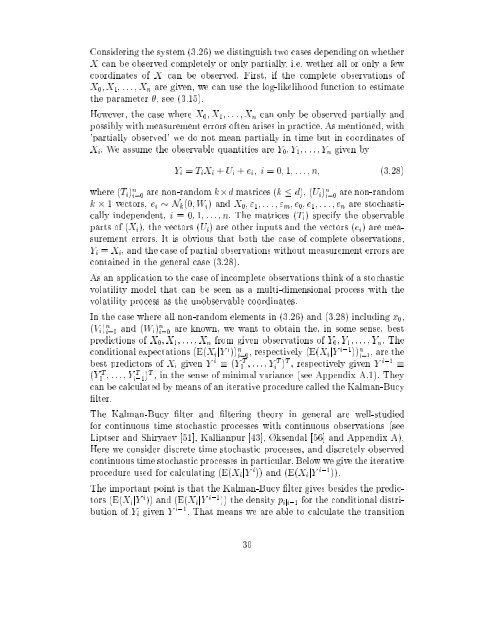Estimation in Financial Models - RiskLab
Estimation in Financial Models - RiskLab
Estimation in Financial Models - RiskLab
Create successful ePaper yourself
Turn your PDF publications into a flip-book with our unique Google optimized e-Paper software.
Consider<strong>in</strong>g the system (3.26) we dist<strong>in</strong>guish two cases depend<strong>in</strong>g on whether<br />
X can be observed completely or only partially, i.e. wether all or only a few<br />
coord<strong>in</strong>ates of X can be observed. First, if the complete observations of<br />
X 0 ;X 1 ;:::;X n are given, we can use the log-likelihood function to estimate<br />
the parameter , see (3.15).<br />
However, the case where X 0 ;X 1 ;:::;X n can only be observed partially and<br />
possibly with measurement errors often arises <strong>in</strong> practice. As mentioned, with<br />
'partially observed' we do not mean partially <strong>in</strong> time but <strong>in</strong> coord<strong>in</strong>ates of<br />
X i . We assume the observable quantities are Y 0 ;Y 1 ;:::;Y n given by<br />
Y i = T i X i + U i + e i ; i =0; 1;:::;n; (3.28)<br />
where (T i ) n i=0<br />
are non-random kd matrices (k d), (U i ) n i=0<br />
are non-random<br />
k 1 vectors, e i N k (0;W i ) and X 0 ;" 1 ;:::;" m ;e 0 ;e 1 ;:::;e n are stochastically<br />
<strong>in</strong>dependent, i = 0; 1;:::;n. The matrices (T i ) specify the observable<br />
parts of (X i ), the vectors (U i ) are other <strong>in</strong>puts and the vectors (e i ) are measurement<br />
errors. It is obvious that both the case of complete observations,<br />
Y i = X i , and the case of partial observations without measurement errors are<br />
conta<strong>in</strong>ed <strong>in</strong> the general case (3.28).<br />
As an application to the case of <strong>in</strong>complete observations th<strong>in</strong>k of a stochastic<br />
volatility model that can be seen as a multi-dimensional process with the<br />
volatility process as the unobservable coord<strong>in</strong>ates.<br />
In the case where all non-random elements <strong>in</strong> (3.26) and (3.28) <strong>in</strong>clud<strong>in</strong>g x 0 ,<br />
(V i ) n i=0<br />
and (W i ) n i=0<br />
are known, we want to obta<strong>in</strong> the, <strong>in</strong> some sense, best<br />
predictions of X 0 ;X 1 ;:::;X n from given observations of Y 0 ;Y 1 ;:::;Y n . The<br />
conditional expectations (E(X i jY i )) n i=0, respectively (E(X i jY i,1 )) n i=1, are the<br />
best predictors of X i given Y i (Y T<br />
0<br />
;:::;Yi<br />
T ) T , respectively given Y i,1 <br />
(Y T<br />
0<br />
;:::;Yi,1) T T , <strong>in</strong> the sense of m<strong>in</strong>imal variance (see Appendix A.1). They<br />
can be calculated by means of an iterative procedure called the Kalman-Bucy<br />
lter.<br />
The Kalman-Bucy lter and lter<strong>in</strong>g theory <strong>in</strong> general are well-studied<br />
for cont<strong>in</strong>uous time stochastic processes with cont<strong>in</strong>uous observations (see<br />
Liptser and Shiryaev [51], Kallianpur [43], ksendal [56] and Appendix A).<br />
Here we consider discrete time stochastic processes, and discretely observed<br />
cont<strong>in</strong>uous time stochastic processes <strong>in</strong> particular. Belowwe give the iterative<br />
procedure used for calculat<strong>in</strong>g (E(X i jY i )) and (E(X i jY i,1 )).<br />
The important po<strong>in</strong>t is that the Kalman-Bucy lter gives besides the predictors<br />
(E(X i jY i )) and (E(X i jY i,1 )) the density p iji,1 for the conditional distribution<br />
of Y i given Y i,1 . That means we are able to calculate the transition<br />
30
















